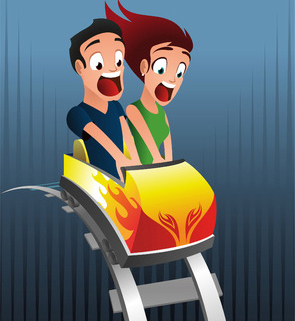
Have you ever been on a rollercoaster? It’s a pretty exciting ride isn’t it and once you are on there, there is no getting off so you have to just shut your eyes and go for the ride. Think about how you felt at the end, you are both excited and exhilarated from the pure adrenaline rush you just had from the ride. Now think about how you feel after going for a ride on your horse…are these feelings similar? If they are, then you have a problem!
‘My horse needs two people to hold him when I mount.’ ‘My horse always has a buck when I first get on him.’ ‘My horse gets really strong on the way home…..but other than that, he is really good and I love him!’
Incredibly, these are just a few examples of things that I see people accept from their horses as normal behavior – because he is a horse and horses do those sorts of things right? Yes, a right brained and unconfident horse will do these sorts of things, but why are we accepting this? It seems to me that people just don’t think that they can do anything about a horses instinct reactions and that to be able to ride our horses, we have to accept these undesirable behaviours that they display.
For some people, it might be a bit of fun riding that 500kg animal and you manage to stay on top when things go pear shaped but really it is like playing a game of Russian roulette. When a horse is acting on his instincts, to the horse, it is fair dinkum, he needs to get away from whatever it is that is causing him fear and if a horse feels that his life is in danger, he will do whatever it takes to get away. WHAT EVER IT TAKES, no matter how much you think he likes you.
But if we don’t ride horses as they are, does that mean we shouldn’t be riding them at all? Not at all, but you don’t have to ride the horse that is listening to his instincts, you can teach your horse to think, help him become braver and change his response to fear. I must warn you though, this isn’t a quick fix. It does require some time and some effort on your part, but what is the option? To keep riding your horse and hope that you live through it? Or to put some hard work in yourself and reap the rewards of truly enjoying riding your horse? To just be able to pull him out of the paddock, saddle him up with no hassles and to take him out and have a peaceful time together, just you and your horse, no worrying about what is going to happen when you turn for home, no worrying about what will happen if that kangaroo hops out in front of you, or the monster that you can’t see but seems very real to your horse. It is possible.
How I hear you ask? There are 3 things that we can do to do to help our horses become much safer and our experiences with them much more enjoyable.
Horses and humans are very different creatures and to be able to really get along with our horses we need to start to look at things from their perspective, to really put ourselves in their shoes, to feel what it is like to be an animal that is being handled by someone who could at any moment, eat them! We all know we are not going to do that, but did anyone tell our horses that? If we can start to see the world from our horses eyes, then we will have more success with giving them what they need. We will be able to start working with our horses, build a good relationship with them and keep them happier.
As humans, we are very good at solving problems and the shortest way of doing that, the better so when it comes to problems with our horses, we end up reaching for that quick fix that really only ends up covering up the symptom and not really getting to the cause. If we never address the cause of the problem and continue to cover up the symptoms then the problem bubbles away under the surface, just waiting for that moment to come out.
The third thing we need to do is look at teaching our horses how to cope in our world. Horses have survived for millions of years and the thing that has kept them alive all this time is their flight from fear response. When there were no fences, floats and stables, this worked fine for them. But we have changed the world. We now want them to walk onto a float, to go through narrow gateways, to be tied up and most of all, we want to ride them. This flight from fear response is now not only dangerous for our horses, it is for us when we are sitting on top of these creatures so it is our responsibility to teach our horses how to think their way through scary situations rather than to go to their instincts and run.
Next time you saddle your horse up, hop on and feel that something isn’t quite right, think about whether you want to go for the roller-coaster ride, or would you like to avoid the adrenaline rush and start to enjoy your ride for the pure unity of the two of you working together. Which ride are you going to take?